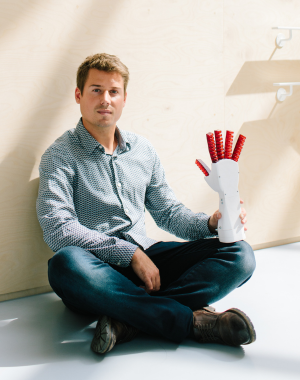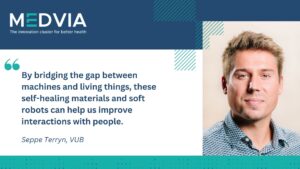Researchers at MEDVIA member Vrije Universiteit Brussel (VUB) have developed self-healing materials that can be used to create soft robots, with the potential to improve human-machine interactions in healthcare. The scientists are now on the hunt for industry partners to take the next steps towards turning their academic breakthrough into commercial products.
25 September 2024

Some of humanity’s most innovative breakthroughs have happened when scientists turn to the natural world – aviation was made possible by mimicking bird wings, for example, and dolphin echolocation gave us sonar. In robotics, there is a growing field based on this type of biomimicry called soft robotics, where researchers are developing technology that imitates how humans and other organisms move and function.
Most living creatures are made of a combination of hard and soft matter – like bones and muscles. VUB and imec-affiliated roboticist Dr Seppe Terryn has been working with an international consortium to replicate this combination, developing new materials and machines that can fulfil functions unsuited to hard robots.“Soft robots are better at handling delicate objects,” Terryn explains. “This makes them appropriate for specialized industrial applications, such as automation of fruit handling in agrifood companies.”
Soft robots also enable improved human-to-robot interactions, making it possible for humans and robots to operate together safely and comfortably, says Terryn: “This is especially important in healthcare, where these robots will be used in areas like rehabilitation, prosthetics, exoskeletons and even minimally-invasive surgery. Their flexibility and softness allow for gentle contact, reducing the risk of injury and ensuring safer collaboration between people and machines.”
Automatically good as new
The soft materials used for robotics are often specialized types of flexible polymers that are stretchable and bounce back to their initial shape, similar to rubber or silicone. But the problem with these materials is that their softness also makes them vulnerable – just like human skin, they’re more likely to be damaged than metal or hard plastic.
To solve this issue, Terryn and his lab have been developing self-healing materials. “We’ve created polymers that can automatically heal from both minor and more serious injuries,” says Terryn.
The lab has patented a specific chemical composition of polymer chains which are connected in a network structure. This is why the material has an elastic property: if you apply pressure, the chains will resist and spring back into shape when you stop poking the material.
“The truly special thing about this material is that we’ve made the connections between the polymer chains out of reversible covalent bonds. This means that if you cut them, each broken connection will generate reactive components that automatically reconnect the strands. The result is a chemically self-healing material that naturally reforms after being cut.”
Because this re-binding happens at the molecular level, the material fully recovers its initial composition and properties. Unless the healing site is contaminated by dirt or other particles, the polymer is as good as new – the lab has tested their material with repeated damage, and even after 60 cuts it retains its original strength and integrity.
“We’ve used this material to create some incredible soft robots, including a bionic hand where we can literally cut off a finger, embedded sensors and all, and then have that finger reattach itself without any loss of function.”
Sustainable surgical trainers

Terryn’s lab is now in the process of connecting with potential industry partners to find suitable applications for their technology. This includes the healthcare sector, where Terryn believes the self-healing material can be employed in a range of different uses beyond soft robotics, including specialized surgical trainers for medical students.
Surgical training is currently primarily conducted on artificial skin patches with limited realism. These are single-use, disposable tools, creating unrecycled waste and making the training expensive. As an alternative, Terryn is envisioning a next generation of realistic, reusable surgical trainers using his team’s self-healing materials.
“A nice feature of our materials is that they are adaptable,” Terryn explains. “We can imitate many different types of organic materials, including bone, muscle, fat and sinew. We can also chemically bind these materials together, creating a model that very closely mimics connective tissues and organs in the body.”
The lab is even able to insert self-healing sensors into their models, which could register the scalpel cuts of student doctors, providing a score for the success of the ‘test’ surgery. “Then, unlike a real body, any of the model’s cuts and damages could be resealed after the session, creating a complex, reuseable surgical trainer.”
Scrapping single-use plastic
Terryn and his fellow researchers have several other ideas for how these materials could be used – in surgical planning, artificial organs, sterile packaging, or even self-healing bandages – but they need industry partners to help them realize the material’s potential. These polymers are marginally more expensive than traditional single-use plastics, which is why the lab is hoping to connect with companies looking to create advanced, specialized equipment, where customers are happy to pay more for a superior product.
“Our materials are bio-based, fully recyclable and can be 3D-printed,” Terryn proudly states. “This is particularly relevant for the healthcare sector, which currently produces a lot of plastic waste. But we know we’re up against a steep slope: We’re providing a new type of material that increases the lifetime of components, making products more resilient, ecological and sustainable. Unfortunately, that goes against many business cases, because we’re currently living in a single-use plastic world.”
 Flanders is a global leader in the development of self-healing materials, but Terryn admits that many of the region’s academic breakthroughs have yet to be developed into commercial products. However, he is hopeful that his lab can match with partners with complementary unmet needs.
Flanders is a global leader in the development of self-healing materials, but Terryn admits that many of the region’s academic breakthroughs have yet to be developed into commercial products. However, he is hopeful that his lab can match with partners with complementary unmet needs.
“By bridging the gap between machines and living things, these self-healing materials and soft robots can help us improve interactions with people, while also providing us with the building blocks we need to make damage-resistant products suitable for long-term use. The potential is vast.”
By Amy LeBlanc



